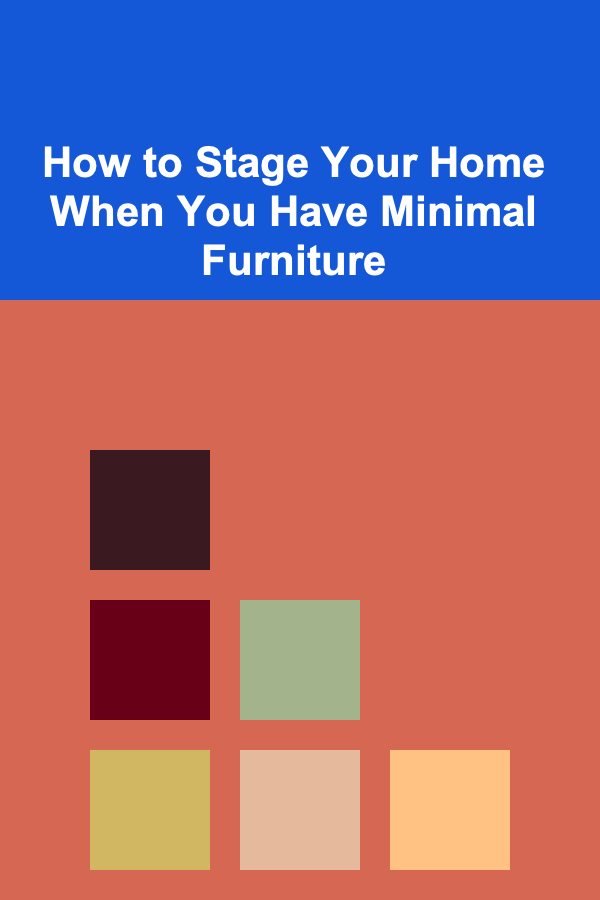
How to Stage Your Home When You Have Minimal Furniture
ebook include PDF & Audio bundle (Micro Guide)
$12.99$6.99
Limited Time Offer! Order within the next:

Staging a home is one of the most crucial steps in preparing a house for sale. Whether you are an experienced seller or a first-time home seller, the way you present your property can make a significant difference in how quickly and for how much you sell your home. However, one challenge that many sellers face is how to stage a home with minimal furniture. Minimalism, while a popular design choice, can be a double-edged sword when it comes to staging. On the one hand, it can create a clean, airy atmosphere, but on the other hand, it can also leave the space feeling empty, cold, or sparse.
The goal of home staging is to create an inviting and functional environment that allows potential buyers to envision themselves living in the space. When you have minimal furniture, achieving this goal can be a challenge, but it is definitely possible. With the right approach, you can make the most out of your minimalist furniture, making your home appear larger, more functional, and more appealing to buyers. In this article, we'll explore strategies and tips for staging your home when you have minimal furniture.
Understand the Power of Furniture in Home Staging
Before diving into how to stage a home with minimal furniture, it's important to understand why furniture plays such an important role in home staging. Furniture serves several purposes:
- Defining Spaces: Furniture helps define each room's purpose. For example, a sofa clearly marks the living room, while a dining table establishes a dining area.
- Creating Flow: Well-arranged furniture can guide the flow of the space, making it feel more cohesive and accessible.
- Adding Warmth and Personality: Furniture adds warmth and character to a room. A space that is too empty may come across as uninviting or lack personality, while a well-furnished space can feel cozy and lived-in.
- Maximizing the Potential of a Room: Buyers need to visualize how they would use a space. A room without furniture can leave them unsure of its purpose, whereas furniture shows how the space can be used effectively.
So, while it's possible to stage a home with minimal furniture, understanding these roles helps you appreciate how to effectively design your layout to compensate for the lack of items.
Create a Sense of Balance
When staging with minimal furniture, one of the key challenges is maintaining a sense of balance in each room. Empty spaces can make a room feel too large or disproportionately bare, which can turn potential buyers off. By carefully selecting and arranging your existing furniture, you can create a sense of balance that makes the space feel inviting and functional, rather than empty.
Use Proportional Furniture Pieces
One way to achieve balance is by using proportionally sized furniture. In rooms with minimal furniture, it's especially important to ensure that each piece fits comfortably in the space without overwhelming it. For example:
- In a small living room, a bulky sofa may overpower the space, while a sleek, modern couch may make the room feel more open and balanced.
- In larger rooms, avoid tiny or too sparse furniture, which can make the room look disproportionately big or empty.
Choosing the right size and scale of furniture is essential when staging a home with minimal items. It's important to choose pieces that fit the dimensions of each room without overcrowding or leaving too much empty space.
Distribute Furniture Evenly
In rooms with minimal furniture, you want to avoid concentrating all the furniture in one corner or along one wall. Distribute the furniture evenly throughout the space to maintain balance and prevent a lopsided feel.
- In the living room, if there's a sofa, place it centrally in the room, with a coffee table in front and perhaps a few accent chairs spread out.
- In a bedroom, place the bed against a central wall, leaving space on either side for symmetry.
This balanced distribution makes the room feel more organized, even if it only contains a few pieces of furniture.
Use Rugs to Define Spaces
In homes with minimal furniture, rugs can be an essential tool for staging. Rugs not only add color, texture, and warmth to a room, but they also serve a practical purpose in defining different areas within a space.
Define the Function of a Room
A rug can be used to clearly demarcate specific zones in an open-concept home. For example:
- In a combined living and dining area, a rug can visually separate the two spaces, creating clear boundaries between them, even if you don't have a lot of furniture.
- In a large bedroom, a rug placed beneath the bed creates a focal point, defining the bed as the central feature of the room and helping to anchor the space.
Choosing a rug that complements the size of the room is key. Too small a rug can look out of place, while a large rug that covers too much of the floor can make the space feel cramped.
Add Color and Texture
Rugs can introduce new colors, patterns, and textures to a room, making it feel more dynamic and inviting. For example, a bold-patterned rug can add personality to a minimalist room, while a neutral-colored rug can help create a calm, serene atmosphere.
Layer Rugs
If you don't have enough furniture, you can still layer rugs to add texture and interest to your space. Layering rugs is a technique that involves placing one rug over another, usually in contrasting colors or textures. This approach not only adds depth and richness to the room but also makes the space feel more cozy and visually appealing.
Maximize Light and Use Mirrors
Minimal furniture doesn't mean you have to sacrifice brightness or warmth. Light plays a significant role in making any space feel more inviting and spacious. In fact, well-lit rooms tend to feel larger and more welcoming. If you have minimal furniture, leveraging natural light and using mirrors can help maximize the sense of space and warmth in your home.
Open Up the Space with Natural Light
When staging your home with minimal furniture, let as much natural light into the space as possible. Open curtains and blinds, and ensure that windows are clean to allow sunlight to flood in. Natural light can help make a room feel more open and airy, compensating for the lack of furniture. A bright room always feels more inviting, even if the furniture is minimal.
Use Mirrors to Expand the Space
Mirrors are another powerful tool when it comes to staging a home with minimal furniture. They can visually expand a space and reflect light, making a room feel larger and more open.
- Place mirrors strategically across from windows to reflect natural light and make the room feel brighter.
- Use large mirrors in entryways or dining rooms to create the illusion of space.
When using mirrors, consider framing them in a way that complements your minimalist decor. A simple, elegant frame can add style without overpowering the simplicity of the space.
Use Strategic Furniture Placement
Even with minimal furniture, the way you arrange your furniture can make a huge difference. Strategic placement is all about optimizing the layout to create a cohesive flow that makes the space feel inviting and functional.
Focus on Functionality
Every piece of furniture should serve a clear purpose, especially in minimalist spaces. You don't want to overcrowd a room, so make sure that each item is intentional and helps to define the function of the space.
For example, in a living room, the sofa should face the main focal point of the room, such as a fireplace or television. In a bedroom, the bed should be placed centrally, with sufficient space on either side for movement and access.
Create Movement Flow
In an open-concept home, arrange furniture in such a way that it encourages easy movement from one area to another. This may mean angling furniture slightly or placing it along walls to keep pathways open. When furniture is too close together or placed without regard for traffic flow, it can make the space feel cramped and uncomfortable.
Add Accessories for Personality
Accessories are a great way to bring life to a space that is otherwise sparse due to minimal furniture. While you don't want to overcrowd the room, a few carefully selected accessories can help to infuse personality and warmth into the space.
Introduce Soft Textures
In addition to rugs, consider incorporating soft textiles like throw pillows, throws, and blankets. These small additions can create a cozy atmosphere and add color or texture to the room without overwhelming it.
- A few well-chosen throw pillows can add pops of color or introduce a pattern to a room.
- A plush throw blanket draped across a sofa or chair can make the space feel inviting and comfortable.
Use Artwork and Decorative Items
Even if you have minimal furniture, a few pieces of artwork or decorative items can create interest and draw attention to the beauty of the space. Simple framed prints, sculptures, or vases can elevate the aesthetic of a room without adding clutter.
The key is to choose items that complement the minimalist design. Avoid overloading the space with too many decorative items, as this can make the room feel busy and cluttered.
Make the Most of Outdoor Spaces
If your home has a balcony, patio, or backyard, don't forget to stage these areas as well. Outdoor spaces are often overlooked in staging, but they are increasingly important to buyers, especially those with families or pets.
Even if you have minimal furniture indoors, you can create an inviting outdoor space with just a few key pieces, such as a bistro table and chairs, a hammock, or a few potted plants.
Outdoor spaces provide an opportunity to expand the feel of your home, and when staged properly, they can add significant appeal to buyers.
Conclusion
Staging a home with minimal furniture may seem like a challenge, but with the right techniques and strategies, it is possible to create an inviting, functional, and visually appealing space. By focusing on balance, using rugs and mirrors effectively, and being strategic with furniture placement, you can highlight the best aspects of your home while compensating for the lack of furniture. By incorporating accessories, making the most of natural light, and showcasing your outdoor spaces, you can create an environment that feels welcoming and allows potential buyers to envision themselves living there. Remember, less can often be more when it comes to staging, so embrace the beauty of minimalism and let your home shine.
Reading More From Our Other Websites
- [Home Storage Solution 101] How to Make Your Closet Look Bigger with Efficient Storage Solutions
- [Organization Tip 101] How to Create a Minimalist Workspace for Creative Flow
- [Survival Kit 101] The Best Off‑Grid Survival Kit for Solar Power & Water Filtration
- [Personal Investment 101] How to Understand Dividends and Use Them to Grow Wealth
- [Home Storage Solution 101] How to Integrate a Murphy Bed with Storage Into a Multi-Purpose Guest Room
- [Home Security 101] How to Protect Your Home from Cyber Threats and Online Risks
- [Home Renovating 101] How to Choose the Right Bathroom Fixtures for Your Renovation
- [Paragliding Tip 101] Future Trends: AI-Powered Kite-Control for Safer Paragliding Adventures
- [Simple Life Tip 101] Best Low‑Maintenance Indoor Plants for Air Purification and Calm
- [Gardening 101] Garden Trellis Designs: How to Make Your Garden More Beautiful

Affordable and Convenient Public Transportation Alternatives You Should Know About
Read More
How to Store Wine in Your Home Without Taking Up Too Much Space
Read More
The Operations Analyst's Playbook: Data-Driven Strategies for Operational Excellence
Read More
How to Write a Business Plan for Profit
Read More
How To Discover Underrated Authors from Around the World
Read More
How to Prepare Your Home for a Move-Out Checklist
Read MoreOther Products

Affordable and Convenient Public Transportation Alternatives You Should Know About
Read More
How to Store Wine in Your Home Without Taking Up Too Much Space
Read More
The Operations Analyst's Playbook: Data-Driven Strategies for Operational Excellence
Read More
How to Write a Business Plan for Profit
Read More
How To Discover Underrated Authors from Around the World
Read More